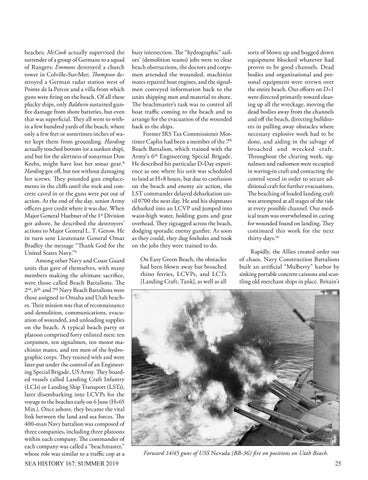beaches; McCook actually supervised the surrender of a group of Germans to a squad of Rangers; Emmons destroyed a church tower in Colville-Sur-Mer; Thompson destroyed a German radar station west of Pointe de la Percee and a villa from which guns were firing on the beach. Of all these plucky ships, only Baldwin sustained gunfire damage from shore batteries, but even that was superficial. They all went to within a few hundred yards of the beach, where only a few feet or sometimes inches of water kept them from grounding. Harding actually touched bottom (or a sunken ship), and but for the alertness of sonarman Don Krebs, might have lost her sonar gear.8 Harding got off, but not without damaging her screws. They pounded gun emplacements in the cliffs until the rock and concrete caved in or the guns were put out of action. At the end of the day, senior Army officers gave credit where it was due. When Major General Huebner of the 1st Division got ashore, he described the destroyers’ actions to Major General L. T. Gerow. He in turn sent Lieutenant General Omar Bradley the message “Thank God for the United States Navy.”9 Among other Navy and Coast Guard units that gave of themselves, with many members making the ultimate sacrifice, were those called Beach Battalions. The 2nd, 6th, and 7th Navy Beach Battalions were those assigned to Omaha and Utah beaches. Their mission was that of reconnaissance and demolition, communications, evacuation of wounded, and unloading supplies on the beach. A typical beach party or platoon comprised forty enlisted men: ten corpsmen, ten signalmen, ten motor machinist mates, and ten men of the hydrographic corps. They trained with and were later put under the control of an Engineering Special Brigade, US Army. They boarded vessels called Landing Craft Infantry (LCIs) or Landing Ship Transport (LSTs), later disembarking into LCVPs for the voyage to the beaches early on 6 June (H+65 Min.). Once ashore, they became the vital link between the land and sea forces. The 400-man Navy battalion was composed of three companies, including three platoons within each company. The commander of each company was called a “beachmaster,” whose role was similar to a traffic cop at a
busy intersection. The “hydrographic” sailors’ (demolition teams) jobs were to clear beach obstructions, the doctors and corpsmen attended the wounded, machinist mates repaired boat engines, and the signalmen conveyed information back to the units shipping men and material to shore. The beachmaster’s task was to control all boat traffic coming to the beach and to arrange for the evacuation of the wounded back to the ships. Former IRS Tax Commissioner Mortimer Caplin had been a member of the 7th Beach Battalion, which trained with the Army’s 6th Engineering Special Brigade. He described his particular D-Day experience as one where his unit was scheduled to land at H+8 hours, but due to confusion on the beach and enemy air action, the LST commander delayed debarkation until 0700 the next day. He and his shipmates debarked into an LCVP and jumped into waist-high water, holding guns and gear overhead. They zigzagged across the beach, dodging sporadic enemy gunfire. As soon as they could, they dug foxholes and took on the jobs they were trained to do. On Easy Green Beach, the obstacles had been blown away but broached rhino ferries, LCVPs, and LCTs [Landing Craft, Tank], as well as all
sorts of blown up and bogged down equipment blocked whatever had proven to be good channels. Dead bodies and organizational and personal equipment were strewn over the entire beach. Our efforts on D+1 were directed primarily toward clearing up all the wreckage, moving the dead bodies away from the channels and off the beach, directing bulldozers in pulling away obstacles where necessary explosive work had to be done, and aiding in the salvage of broached and wrecked craft. Throughout the clearing work, signalmen and radiomen were occupied in waving-in craft and contacting the control vessel in order to secure additional craft for further evacuations. The beaching of loaded landing craft was attempted at all stages of the tide at every possible channel. Our medical team was overwhelmed in caring for wounded found on landing. They continued this work for the next thirty days.10 Rapidly, the Allies created order out of chaos. Navy Construction Battalions built an artificial “Mulberry” harbor by sinking portable concrete caissons and scuttling old merchant ships in place. Britain’s
Forward 14/45 guns of USS Nevada (BB-36) fire on positions on Utah Beach.
SEA HISTORY 167, SUMMER 2019 25
